Personalization Myths vs. Facts in 2025

In 2025, understanding personalization myths can determine your success in connecting with customers. Misconceptions often lead to strategies that feel generic or intrusive, damaging trust. When you separate myths from facts, you create personalized experiences that resonate with your audience. This approach builds loyalty and positions your business as a leader in a competitive market.
Personalization isn’t just a trend—it’s a powerful tool when applied with clarity and purpose.
Key Takeaways
Personalization is more than using names. It means knowing what customers like and need to connect better.
Using data the right way is very important. Being honest about how data is collected builds trust and helps relationships.
AI and machines can make personalization better, but they need smart planning. Mix technology with human ideas for the best outcomes.
Small businesses can do personalization without spending a lot. Be creative and use the data you already have to improve customer experiences.
Customers want things made just for them. Giving them this can make them happier, keep them coming back, and grow your business.
Common Personalization Myths
Personalization is Just About Using Names
Many believe personalization is as simple as adding a customer’s name to an email or message. While using names can create a sense of familiarity, personalization goes far beyond this surface-level approach. You need to consider context, relevance, and timing to truly connect with your audience.
Personalization involves understanding what your customers need and delivering solutions that align with their preferences.
Research shows that technology-enabled personalization (TEP) in retail relies on five key drivers: utilitarian benefits, hedonic experiences, control, interaction, and integration. These factors help businesses create meaningful connections with customers. However, barriers like privacy concerns and lack of confidence can hinder acceptance.
Algorithms on social media curate content based on demographics and personal data.
This enhances relevance but raises concerns about privacy and autonomy.
Personalization isn’t just about names; it’s about creating experiences that feel tailored and valuable.
Personalization Requires Invasive Data Collection
Another common misconception is that personalization demands intrusive data collection. You might worry that gathering personal information will alienate customers or violate their privacy. However, ethical data practices allow you to personalize effectively without crossing boundaries.
Transparency is key. When you explain how and why you collect data, customers are more likely to trust your brand. Focus on collecting only the information you need to improve their experience. For example, instead of asking for sensitive details, you can use purchase history or browsing behavior to recommend relevant products.
Ethical personalization builds trust and ensures customers feel respected.
By prioritizing privacy and using data responsibly, you can deliver personalized experiences without compromising customer confidence.
AI and Automation Make Personalization Effortless
It’s tempting to think that AI and automation can handle personalization entirely on their own. While these tools are powerful, they require strategic input to be effective. You need to guide AI systems with clear goals and ensure they align with your brand’s values.
A recent study revealed that 34% of businesses struggled with limited AI skills and knowledge, which hindered effective implementation. Additionally, 40% of marketers expressed concerns about data privacy and ethical issues related to AI in marketing.
Evidence Type | Description |
|---|---|
Knowledge Gap | 34% of businesses reported limited AI skills and knowledge as a barrier. |
Ethical Concerns | 40% of marketers worried about privacy and ethical issues in AI marketing. |
AI can enhance personalization, but it’s not a magic solution. You need to combine automation with human insight to create strategies that resonate with your audience.
Personalization Only Works for Big Businesses
A common misconception is that personalization is only feasible for large corporations with vast resources. This belief stems from the idea that personalization requires expensive tools, extensive data, and dedicated teams. However, small businesses can also implement effective personalization strategies without breaking the bank.
You can start by leveraging the data you already have. For example, analyzing customer purchase history or website behavior can help you recommend relevant products or services. Tools like email marketing platforms and CRM software often include built-in personalization features that are affordable and easy to use. These tools allow you to segment your audience and tailor your messages based on their preferences.
Personalization doesn’t require a massive budget—it requires creativity and a focus on customer needs.
Small businesses also have an advantage in building personal connections. With fewer customers, you can engage more directly and create a sense of community. For instance, sending a handwritten thank-you note or offering a personalized discount can leave a lasting impression. These small gestures show that you value your customers as individuals.
Customers Don’t Care About Personalization Anymore
Another myth suggests that customers no longer value personalization. Some believe that consumers have grown indifferent to tailored experiences due to overexposure. However, recent data tells a different story. Customers not only care about personalization but also expect it from the brands they interact with.
A survey revealed the following insights:
Statistic | Percentage |
|---|---|
Consumers who ignore irrelevant ads | |
Consumers likely to purchase with personalized messages | 96% |
Shoppers frustrated by irrelevant messages | 71% |
Consumers less likely to purchase after generic messages | 25% |
Consumers wanting brands to learn from shopping habits | 71% |
Consumers likely to purchase from relevant recommendations | 77% |
Consumers wanting more personalized communications | 90% |
Consumers who value brands remembering preferences | 66% |
Consumers who value relevant product suggestions | 52% |
Consumers who value brands remembering past interactions | 47% |
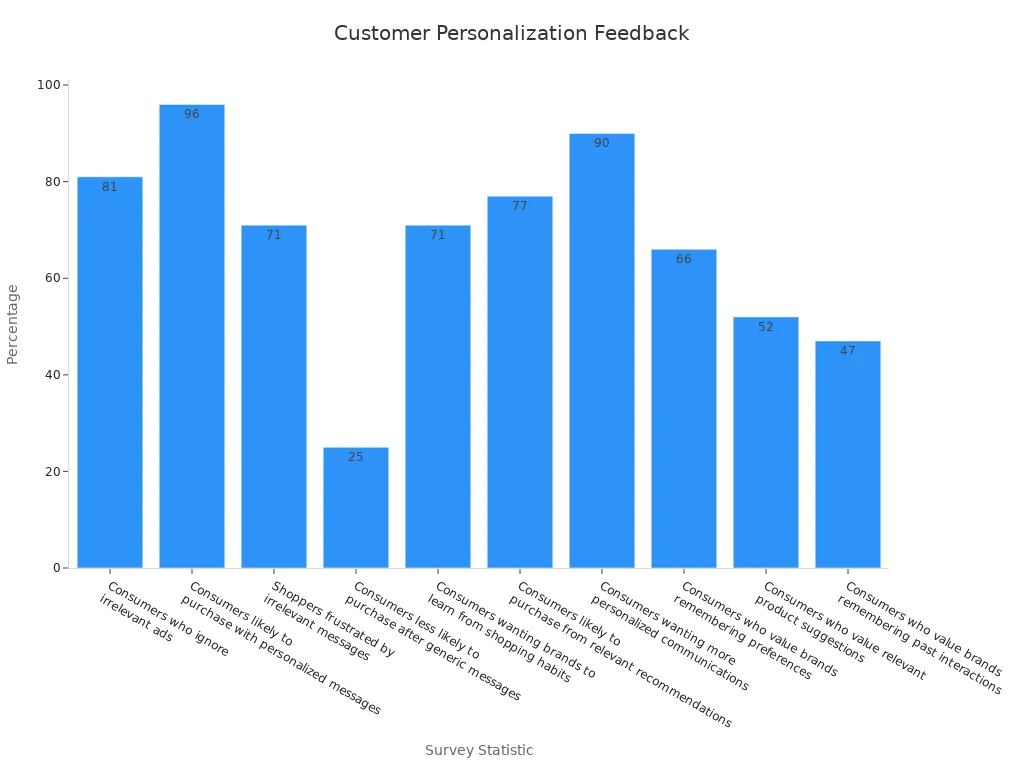
These statistics highlight the importance of personalization in today’s market. For instance, 96% of consumers are more likely to make a purchase when they receive personalized messages. On the other hand, 71% of shoppers feel frustrated by irrelevant messages, and 25% are less likely to buy after receiving generic communications.
You can meet these expectations by focusing on relevance and timing. Instead of bombarding customers with generic promotions, tailor your messages to their interests and past interactions. For example, if a customer browsed a specific product, you could send a follow-up email with a discount or related recommendations.
Personalization isn’t just appreciated—it’s expected. When done right, it enhances the customer experience and drives loyalty.
Facts That Counter Personalization Myths
Personalization Goes Beyond Names: Context and Relevance Matter
Using a customer’s name in communication is just the tip of the iceberg. True personalization involves understanding the context of your customer’s needs and delivering relevant solutions. For example, if a customer frequently purchases fitness gear, recommending workout accessories or sharing fitness tips can create a meaningful connection. This approach shows that you understand their preferences and care about their interests.
Businesses that embrace this deeper level of personalization see measurable results. Marketers report a 25% lift in ROI when using AI-powered personalization. Companies leveraging AI-driven strategies have also experienced a 20% increase in sales. Additionally, organizations report double the customer engagement rates and up to 1.7× higher conversion rates on campaigns.
Here’s how personalization impacts different industries:
Industry | Current Revenue Increase | Projected Future Increase | Growth Percentage |
|---|---|---|---|
Fintech | 43% | 169% | |
Digital Banking | 16% | 38% | 138% |
Retail & eCommerce | 16% | 30% | 88% |
Real-world examples further highlight the power of context and relevance:
A major retailer saw a 15% increase in conversion rates after implementing real-time product recommendations.
A subscription service provider reduced churn by 10% through personalized email campaigns triggered by user behavior.
Personalization that focuses on context and relevance transforms customer interactions into valuable experiences.
Ethical Data Practices Enable Effective Personalization
Many consumers feel uneasy about how companies collect and use their data. A study by Adobe found that 70% of consumers worry about data collection practices. Similarly, a Deloitte report revealed that 75% of consumers fear data misuse. These concerns highlight the importance of ethical data practices in building trust and fostering engagement.
Transparency plays a crucial role in alleviating these concerns. When you explain why you collect data and how it benefits your customers, they are more likely to trust your brand. For instance, instead of asking for sensitive information, you can use browsing history or past purchases to offer tailored recommendations. Ethical data practices not only respect individual rights but also promote transparency, which is essential for effective personalization.
Failing to comply with regulations like GDPR can lead to severe consequences. Non-compliance has resulted in over €1.7 billion in fines, and companies risk significant financial losses and reputational damage. David Lewis from SecureSync emphasizes that ethical data governance is not optional—it’s a necessity for sustainable success.
By prioritizing ethical data practices, you can deliver personalized experiences while respecting customer privacy and building long-term trust.
AI is a Tool, Not a Replacement for Strategy
AI has revolutionized personalization by automating repetitive tasks and analyzing large datasets. However, it’s important to remember that AI serves as a supporting tool, not a replacement for strategic thinking. You need to guide AI systems with clear objectives and ensure they align with your brand’s values.
AI excels at tasks like sifting through data to extract actionable insights and optimizing budget allocation. For example, predictive analytics can help you maximize ROI by identifying high-performing campaigns. AI also complements human agents in customer service, allowing them to focus on tasks that require emotional intelligence.
Evidence Description | Role of AI in Personalization |
|---|---|
AI algorithms automate repetitive tasks, allowing human employees to focus on complex activities. | AI serves as a supporting tool by enhancing efficiency and enabling human creativity in personalization. |
AI sifts through large datasets to extract actionable insights. | This capability supports marketers in making informed decisions that would be difficult to achieve manually. |
AI helps optimize budget allocation and measures marketing effectiveness. | By providing predictive analytics, AI assists in maximizing ROI, reinforcing its role as a supportive tool. |
AI complements human agents in contact centers, allowing them to focus on emotional intelligence tasks. | This highlights AI's role in enhancing human capabilities rather than replacing them. |
Despite its capabilities, AI cannot replace the human touch. You need to combine AI’s efficiency with your creativity and strategic vision to create personalized experiences that resonate with your audience.
AI is a powerful ally, but your strategy and human insight remain the driving forces behind successful personalization.
Small Businesses Can Leverage Personalization Too
You don’t need a massive budget or a large team to implement effective personalization. Small businesses can use the resources they already have to create meaningful customer experiences. By focusing on creativity and customer needs, you can achieve personalization without overspending.
Start by analyzing the data you already collect. For example, track customer purchase history or website activity. These insights can help you recommend products or services that match their preferences. Many affordable tools, like email marketing platforms and CRM software, offer built-in personalization features. These tools allow you to segment your audience and tailor your messages to their interests.
Tip: Use free or low-cost tools like Mailchimp or HubSpot to get started with personalized email campaigns.
Small businesses also have an advantage in building personal connections. With fewer customers, you can engage more directly. For instance, sending a handwritten thank-you note or offering a birthday discount can make your customers feel valued. These small gestures show that you care about them as individuals.
Here’s how small businesses can leverage personalization effectively:
Segment Your Audience: Group customers based on shared characteristics, like location or buying habits.
Use Social Media: Engage with customers by responding to comments or sharing user-generated content.
Offer Tailored Discounts: Provide special offers based on past purchases or browsing behavior.
Personalization isn’t just for big corporations. It’s about understanding your customers and delivering value in ways that matter to them.
Customers Value Personalization When Done Right
When personalization is executed effectively, customers notice—and they respond positively. Research shows that people are more likely to choose, recommend, and stay loyal to brands that offer personalized experiences. This isn’t just a trend; it’s a proven way to enhance customer satisfaction and drive business growth.
Statistic | Source |
|---|---|
77% of customers have chosen, recommended, or paid more for a brand that provides a personalized experience. | Salesforce |
Epsilon | |
Companies that provide a personalized experience see a 19% increase in sales. | Salesforce |
Companies that provide a personalized experience have a 20% increase in customer satisfaction. | Epsilon |
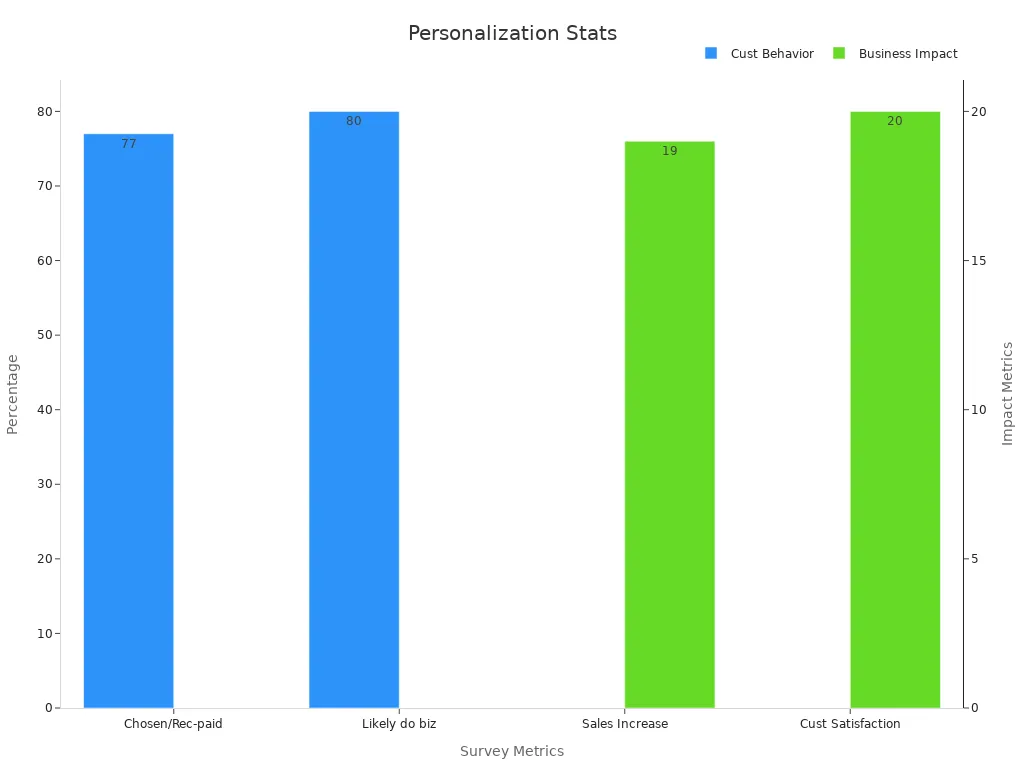
These statistics highlight the importance of personalization. For example, 80% of customers prefer doing business with companies that personalize their interactions. Additionally, businesses that prioritize personalization see a 19% boost in sales and a 20% increase in customer satisfaction.
To ensure your personalization efforts succeed, focus on relevance and timing. Customers appreciate messages that align with their interests and needs. For instance, if someone browses a specific product, follow up with a recommendation or a discount. Avoid generic promotions that feel impersonal or irrelevant.
Note: Personalization isn’t about overwhelming customers with offers. It’s about delivering the right message at the right time.
When done right, personalization builds trust and loyalty. Customers feel understood and valued, which strengthens their connection to your brand.
Why Personalization Matters in 2025

Enhancing Customer Experience and Loyalty
Personalization transforms how customers interact with your brand. Tailored experiences make customers feel valued, which boosts satisfaction and loyalty. Metrics like Customer Satisfaction Score (CSAT), Net Promoter Score (NPS), and Customer Effort Score (CES) confirm this impact.
Metric | Description |
|---|---|
Customer Satisfaction Score (CSAT) | Measures customer satisfaction with a product or service, indicating immediate sentiments. |
Net Promoter Score (NPS) | Assesses customer loyalty and likelihood of recommending a company, predicting business growth. |
Customer Effort Score (CES) | Evaluates the ease of customer interactions, identifying friction points that affect satisfaction. |
When you personalize communications, customers feel understood. For example, recommending products based on past purchases or sending birthday discounts creates memorable moments. These efforts improve loyalty and encourage repeat business.
Personalization isn’t just about selling—it’s about building relationships that last.
Driving Conversions and Revenue Growth
Personalization directly impacts your bottom line. Businesses that excel in personalization generate 40% more revenue than slower adopters. Personalized emails achieve transaction rates six times higher than generic ones.
Statistic | Value |
|---|---|
Average conversion rate increase for B2B brands with personalized web experiences | |
Average increase in order value for B2B companies with personalization | 40% |
Transaction rate increase for personalized emails in B2B businesses | 600% (six times higher) |
ROI for retailers investing in personalized customer experience | At least 400% |
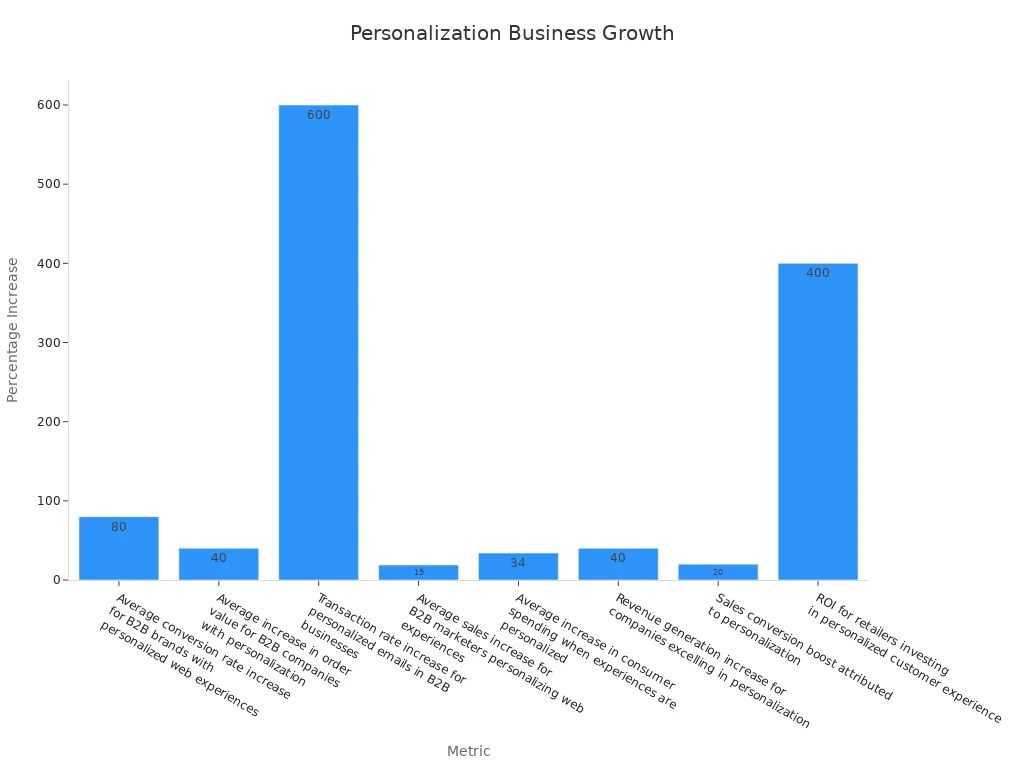
When you tailor your strategies, customers respond positively. They spend more, convert faster, and engage deeply. For instance, personalized web experiences increase average order values by 40%.
Personalization drives measurable growth, making it a must-have strategy for 2025.
Staying Competitive in a Saturated Market
In 2025, personalization isn’t optional—it’s essential for staying ahead. Studies show that 89% of marketing decision-makers and 75% of company executives view personalization as critical for success. Fast-growing companies generate 40% more revenue through personalization, while 71% of customers expect tailored experiences.
Statistic | Source |
|---|---|
89% of marketing decision-makers consider personalization essential | |
75% of company executives view personalization as essential for digital | |
40% more revenue generated by fast-growing companies from personalization | |
71% of customers expect personalized experiences |
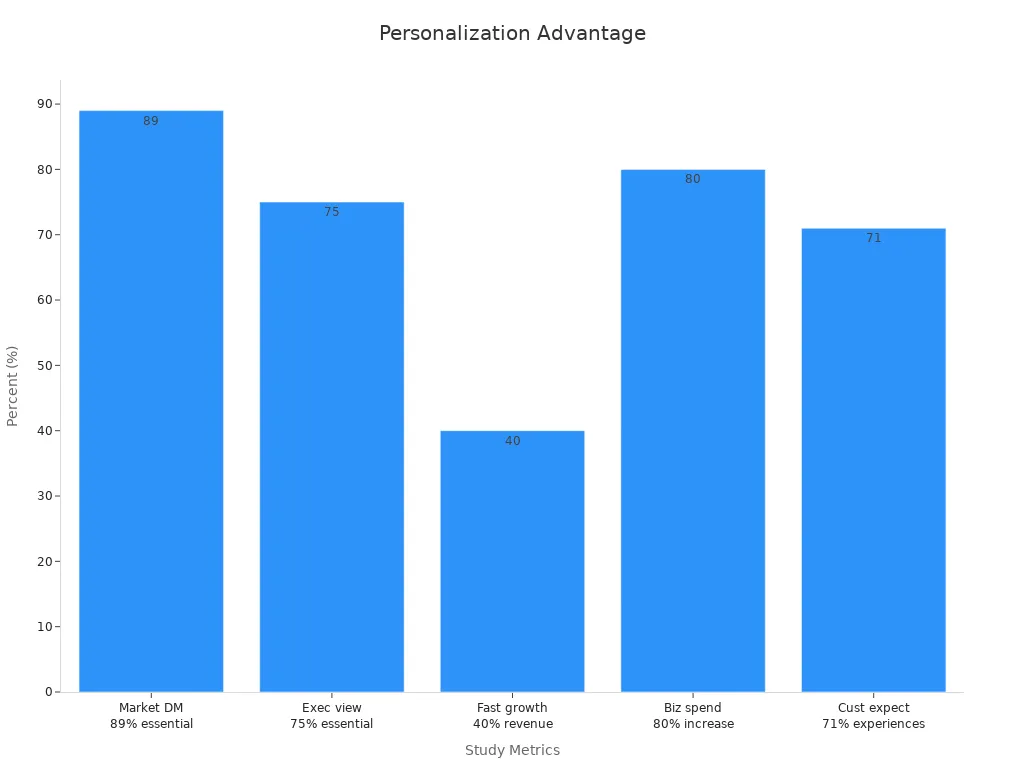
Personalization helps you stand out in crowded markets. By meeting customer expectations, you build trust and loyalty, ensuring your brand remains relevant.
To compete in 2025, you must prioritize personalization as a key strategy.
Meeting Evolving Customer Expectations
Customer expectations are evolving rapidly, and staying ahead of these changes is essential for success in 2025. People now demand more personalized experiences, and they expect businesses to adapt to their preferences seamlessly. Research shows that 73% of customers anticipate better personalization as technology advances. This means you need to focus on understanding their needs and delivering tailored solutions.
The role of technology in meeting these expectations cannot be overstated. For instance, 86% of respondents believe AI will transform customer experiences. AI-powered tools like chatbots and recommendation engines allow you to provide faster, more accurate responses. Additionally, 71% of business leaders plan to increase investments in AI chatbots, highlighting their importance in customer service.
Statistic | Description |
|---|---|
86% | Respondents believe AI will have a transformative impact on customer experience. |
71% | Leaders plan to increase investment in AI chatbots for customer service. |
55% | Customers prefer self-service channels over speaking to a support representative. |
73% | Customers expect better personalization as technology advances. |
80% | Customers consider the experience a company provides as important as its products and services. |
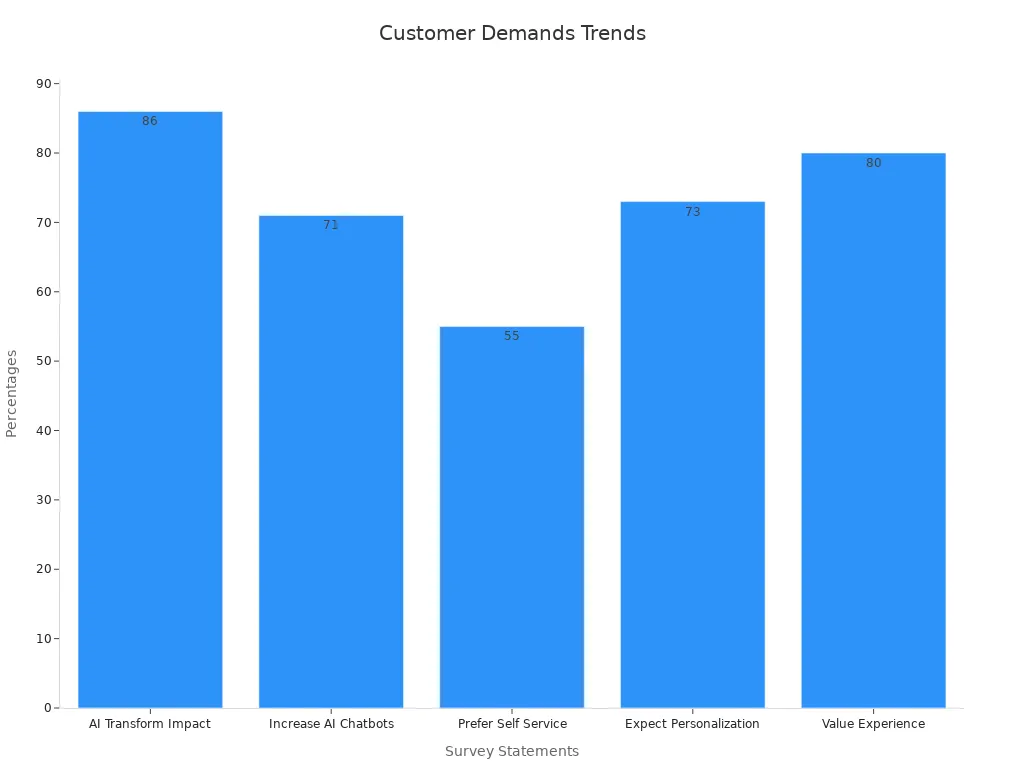
Customers also value consistency and adaptability. Around 79% expect consistent interactions across departments, while 65% want companies to adjust to their changing needs. To meet these demands, you should focus on creating a unified customer experience. For example, integrating data across platforms ensures that every interaction feels seamless and relevant.
Tip: Use AI tools to analyze customer behavior and predict future needs. This helps you stay proactive and deliver experiences that exceed expectations.
By prioritizing personalization and leveraging technology responsibly, you can meet the evolving demands of your customers. This approach not only enhances satisfaction but also builds long-term loyalty.
Practical Tips for Effective Personalization

Start with Clear Goals and Audience Segmentation
Effective personalization begins with setting clear goals and understanding your audience. Without defined objectives, your efforts may lack focus and fail to deliver results. Start by identifying what you want to achieve—whether it’s increasing conversions, boosting customer loyalty, or improving engagement. Clear goals guide your strategy and ensure your actions align with your business priorities.
Audience segmentation plays a crucial role in this process. By grouping customers based on shared characteristics, such as demographics, behavior, or preferences, you can create tailored experiences that resonate. For example, segmenting by purchase history allows you to recommend relevant products, while grouping by location helps you deliver region-specific offers.
Why it matters:
Defined goals improve campaign performance by aligning strategies with marketing objectives.
Segmentation fosters loyalty and drives revenue by delivering personalized experiences.
Personalization thrives when you know your audience and have a clear roadmap for success.
Use Data Responsibly and Transparently
Customers trust brands that handle their data with care. To build this trust, prioritize transparency in your data practices. Clearly explain how you collect, store, and use customer information. For instance, let customers know that their browsing history helps you recommend products they’ll love.
Brands like Netflix and Amazon excel at this. Netflix uses viewing history to suggest shows, reducing churn and keeping users engaged. Similarly, Amazon’s recommendations based on past purchases enhance the shopping experience. These practices demonstrate how responsible data use can strengthen relationships.
Tips for ethical data use:
Communicate your commitment to protecting customer privacy.
Inform customers how their data enhances their experience.
Transparency reassures customers and fosters long-term loyalty.
Leverage AI and Automation Strategically
AI and automation can elevate your personalization efforts when used wisely. These tools analyze vast amounts of data to uncover insights and deliver tailored experiences. For example, AI-powered recommendation engines can boost ecommerce conversion rates by 15.72%.
Companies like IBM and Accenture showcase the power of AI. IBM’s AI-driven system provides personalized feedback, improving employee engagement. Accenture’s platform creates tailored development plans, streamlining evaluations. These examples highlight how strategic AI integration enhances outcomes.
Use AI as a tool to complement your strategy, not replace it. Combine its efficiency with human creativity for the best results.
Test, Measure, and Optimize Continuously
Personalization isn’t a one-and-done effort. To succeed, you need to test, measure, and refine your strategies regularly. This approach ensures your efforts stay effective and relevant to your audience.
Start by experimenting with different personalization elements. A/B testing allows you to compare variations, such as product recommendations or messaging styles, to see which performs better. For example:
Testing personalized product suggestions can reveal what resonates most with your audience.
Tailoring promotions to specific customer segments has led to significant results, like a 30% conversion rate increase for one e-commerce company.
Monitoring metrics like click-through rates and engagement levels during these tests provides valuable insights.
Tip: Use these insights to adjust your strategies and improve outcomes over time.
Optimization doesn’t stop at testing. Regularly review your audience’s preferences and behaviors. Trends shift, and what worked last year may not work today. By staying proactive, you can keep your personalization efforts fresh and impactful.
Balance Personalization with Privacy
While personalization enhances customer experiences, it must respect privacy. Striking this balance builds trust and ensures compliance with legal standards.
Regulations like GDPR and CCPA require transparency in data collection. They also give consumers control over their personal information. To meet these requirements, focus on ethical practices:
Limit data collection to what’s necessary. This reduces the risk of breaches and protects customer privacy.
Clearly explain how you use data. Transparency reassures customers and fosters loyalty.
Regularly review your compliance with privacy laws to avoid legal issues.
Note: Customers value personalization, but they won’t tolerate misuse of their data.
By prioritizing privacy, you show respect for your audience. This approach not only safeguards your reputation but also strengthens customer relationships.
Debunking personalization myths helps you avoid common pitfalls and build trust with your audience. Misconceptions often lead to ineffective strategies, but understanding the facts allows you to create meaningful customer experiences.
Personalization strengthens customer relationships and increases satisfaction.
It simplifies the customer journey, making your communications more impactful.
Businesses that embrace personalization foster loyalty and gain brand advocates.
In 2025, digital marketing plays a vital role in business growth. Real-time analytics and scalability make personalized marketing more accessible than ever. By adopting ethical practices and focusing on relevance, you can deliver value while respecting privacy.
Personalization isn’t just a strategy—it’s a commitment to understanding and serving your customers better.
FAQ
What are the biggest challenges with personalization in 2025?
You may face challenges like balancing personalization with privacy, managing ethical data practices, and adapting to evolving customer expectations. Using AI strategically and staying compliant with regulations can help you overcome these hurdles.
How can small businesses compete with larger companies in personalization?
Small businesses can leverage affordable tools like CRM software and email platforms. Focus on creativity and customer needs. Personal touches, such as handwritten notes or tailored discounts, can make a big impact.
Is personalization only about marketing?
No, personalization extends beyond marketing. It improves customer service, product recommendations, and loyalty programs. Tailored experiences across all touchpoints enhance satisfaction and build stronger relationships.
How do ethical data practices impact personalization?
Ethical data practices build trust and ensure compliance with regulations. Transparency about data collection and usage reassures customers. Responsible practices also protect your reputation and foster long-term loyalty.
Are customers tired of personalization?
Customers value personalization when it’s relevant and respectful. Irrelevant or intrusive efforts frustrate them. Focus on delivering tailored experiences that align with their preferences and needs.
See Also
Why Need-Based Recommendations Outperform Standard Purchase Suggestions
Understanding Short-Term Demand Predictions: Techniques And Challenges
The Impact Of Weather Changes On Demand Across Sectors
How TikTok’s Content Graph Drives Retail Success
Exploring The Main Differences Between Omnichannel And Multichannel

